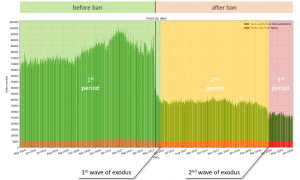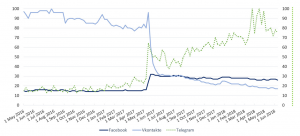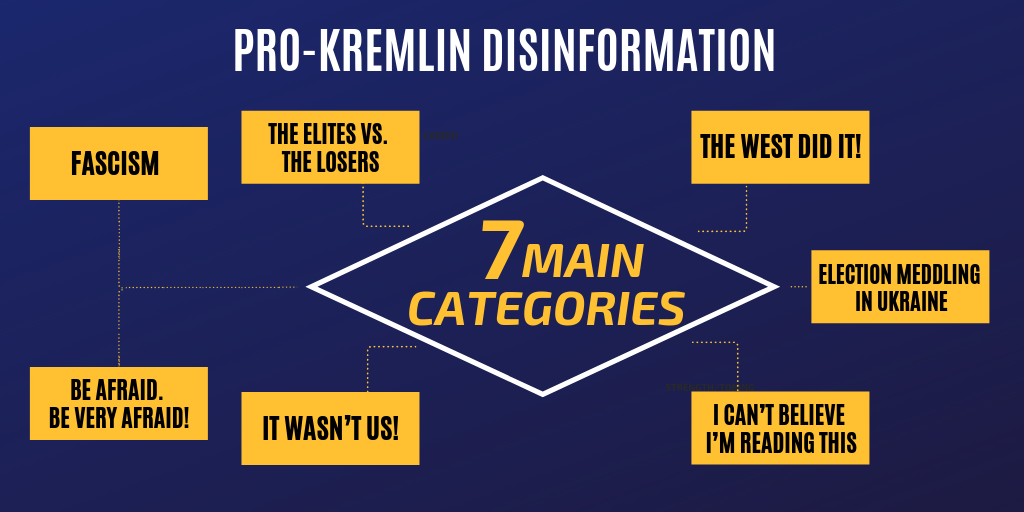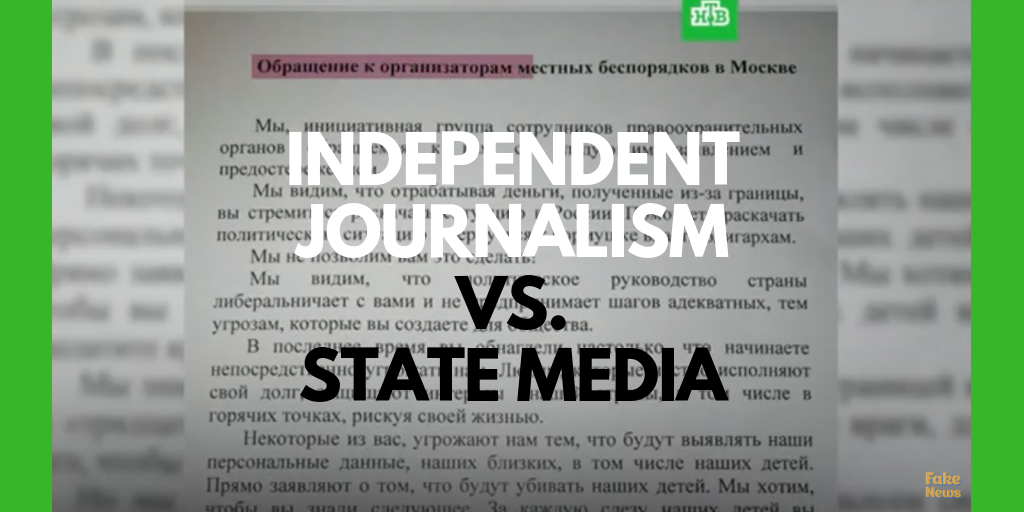The Ukrainian Law "On Sanctions" states that sanctions have been imposed in order “to protect the national security and territorial integrity of Ukraine, to counteract terrorism, and to prevent violations of the rights, freedoms, and interests of the citizens, society, and state of Ukraine”. The largest Internet companies banned include the Russian social networks VKontakte (VK) and Odnoklassniki, the search engine company Yandex (including its sites using the .ua domain), and the email service Mail.ru. According to SimilarWeb, the audience for VK in Ukraine decreased by more than 60% as a result of the ban.

Because the ban does not apply to the territories occupied by Russia, the study determined two target regions: government-controlled areas (GCA) subject to the ban, and non-government-controlled areas (NGCA) where the ban was not imposed (Crimea, DNR, and LNR).
Posting dynamics over time
The ban was effective in some aspects, particularly for the decrease of actively involved users. It’s clearly visible by the number of posts per day. Before the ban, the total number reached 101,000 posts per day. After the ban, the mean number of posts decreased to 38,000 on average. Since April 2018, the traffic decreased by 10,000 again and stabilized at that level. Thus, the period of study (between 1 May 2016 and 14 June 2018) was divided into three intervals: before the ban, the first ‘user exodus’, and the second ‘user exodus’.

The first user exodus could be explained by law-abiding citizens’ rejection of VK, and by the inability of the rest to use virtual private networks [VPNs]. The second wave may have been caused by those who remained realizing they had lost their audiences, making activity on VK less interesting to them.
The user exodus doesn’t necessarily mean that users have deleted their accounts but ceased to post anything in the network. Both waves of users leaving VK were accompanied by peaks of activity on other social media. There was a significant surge in the use of Facebook search queries in mid-May 2017, and two spikes in the use of Telegram search queries in May 2017 and April 2018.

The average age of users (as stated on their profiles) did not change in the occupied areas, while the average age of users in the GCA decreased in 1.7 years on average. This may have been a result of younger people using mobile phones to browse the internet and access the social network, compounded by the fact that older people may be less familiar with VPNs, which could help them get around the ban.

A social graph above, depicting the connections between ~ 2 000 random users from the GCA, was created to analyze the user exodus in greater detail. Only active users were included in the sample. As shown in the diagram, the most-connected users, located in the central part of the graph, mostly continued to use VK (marked red), while less-connected
users, located on the periphery, left the social network during either the first exodus (marked green) or the second exodus (marked yellow). In addition, users who posted more frequently were also more likely to stay (the majority of large nodes are red).

Despite a large number of users left the network, those who remained have become more densely connected, acquiring more friends and subscribing for more groups. This is the trend both for GCA and NGCA, but for the GCA it’s stronger.
Dominating ideology in the Network before and after the ban
From quite diverse ideological posts with strong Russian presence before the ban, the VK infosphere has changed to predominantly Russian or pro-Russian.
Several main clusters of ideological posts were identified in the before and after ban samples as well as their share in each sample defined. The number of ideological posts after the ban increased by 1.22 times compared with the period before the ban.

Main clusters of ideological posts are depicted on the Scheme above. It is clear that after the ban the audience of VK has been moving to the pro-Russian infosphere. Several pro-Ukrainian clusters (“Pro-Ukrainian rhetoric”, “Patrol Police”) disappeared at all, while others decreased in the number of posts (“Ukraine news”). Pro-Russian clusters, conversely, increased in their size (“Pro-Russian propaganda”, “DNR and LNR”), and several new Russian emerged (“Russia news”, “Donald Tramp and the USA”).
Most of user accounts posting about ideological issues before the ban continued to use VK after the ban, unlike 2/3 of private personal accounts which quit the network. 467 such ideological profiles were identified from both regions. Only 35 profiles from the GCA and four profiles from the NGCA left the network.
The more thorough examination of those who continued to disseminate ideological, usually anti-Ukrainian posts after the ban, reveals that the share of small accounts posting ideological posts (less than 50) has increased 17 times after the ban, while a share of those large posting more than 1500 ideological posts decreased 2,5 times. This means that small profiles of individuals have become more involved in disseminating ideological messages than large pages.
Ideological users have also become significantly more interconnected than typical users after the ban. While the typical user had on average 195 friends before the ban and 217 after the ban, the number of friends for an ideological user grew from 197 to 501.
Further threats
Despite the considerable success of threefold decline in the general number of posts (which corresponds to the decline in the number of users), the remaining users have become yet more ideologically active and pro-Russian. They have lost any opposition or alternative views in the network, which could make them less radical before. Also, they’ve become more interconnected after the ban. A kind of informational bubble was created for those users who still use VK. The same messages are posted and reposted by remaining users and the twofold result follows: the general population has become more disconnected from Russian propaganda, while remaining minority yet more embedded in it.
Read also:
- How Russian “troll factory” tried to influence Ukraine’s agenda: analysis of 755,000 tweets
- EU disinformation watchdog has collected over 5000 disinformation cases since November 2015
- Distraction as a tool of Russian propaganda'
- Propaganda contractors: Russian state TV airs staged interview to denigrate Ukraine
- How pro-Kremlin think tanks spread propaganda in the West
- How to get a 146% election result: Background of Kremlin propaganda classic case explained





